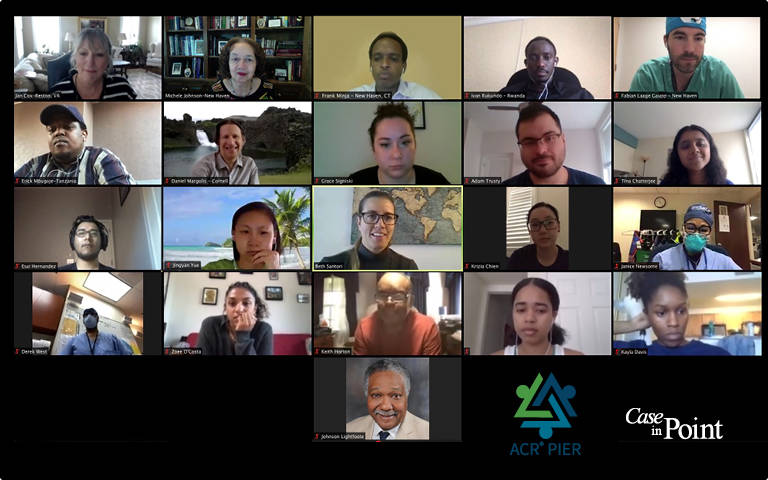The importance of mentoring medical students and connecting young talent to radiology continues to be top of mind for the ACR. Hence, the ACR Commission for Women and Diversity started the Pipeline Initiative for the Enrichment of Radiology (PIER) program in 2016. The goal of PIER is to introduce medical students to the field early — particularly those from backgrounds underrepresented in the specialty.
“The idea is we’re going to advance diversity one student at a time by exposing them to a wide range of radiology,” says Michele H. Johnson, MD, FACR, professor of radiology and biomedical imaging at Yale School of Medicine and director of the PIER program. Since its inception, the PIER program has grown and adapted, and one of these adaptations came in the form of a 2020 partnership with the ACR’s online Case in Point® (CiP) educational module.
Changing With the Times
The PIER program was launched in conjunction with Nth Dimensions™ — an educational nonprofit that strives to increase diversity in orthopedics and other subspecialty fields of medicine. The program is now run independently by the ACR. For the first three years, five PIER candidate interns were selected to work side-by-side with experienced radiologists in both academic and private practice environments.
Following an orientation at ACR headquarters, all PIER activities and lectures were done onsite at individual institutions, with a variety of lectures and networking opportunities. “At my institution, students attended the lectures for new residents (including diagnostic, IR, and radiation oncology) and accompanied me to the Radiological Society of Connecticut’s meetings so they could meet other radiologists.” says Johnson. “In addition, each of the students worked on research projects with their preceptors that culminated in a poster presentation at the National Medical Association’s (NMA) annual meeting.”
Things took a turn in the spring of 2020, when the COVID-19 pandemic struck and PIER was forced to convert to a virtual setting. Many preceptors and participants began to doubt that the program would be able to continue. But Johnson wasn’t ready to give up just yet. “I said, ‘I think I can write a comprehensive online educational curriculum and assign preceptors, but we need a substitute for the onsite research exposure,’” says Johnson. That’s when she came up with the idea of partnering with CiP as an opportunity to expose the students to research opportunities and presentation skills
Exposing Students to Radiology
The CiP-PIER alliance allows PIER students to work on a case report submission that the PIER preceptor helps them choose (learn more at acr.org/PIER). For many radiology trainees, CiP is an introduction to the publication process and the creation of scholarly work. Additionally, the CiP program introduces early-career radiologists to the ACR, many of whom will become lifelong members of the College. PIER students submitting cases to CiP enjoy an expedited but rigorous review process by CiP editors and they receive feedback during their six-week PIER experience. Once published, cases submitted by the PIER students are viewed by the CiP’s 1,100 average daily readers, many of whom will claim CME credit for completing the case.
Johnson felt the program would be the perfect way to connect with PIER students in an online setting, while getting them exposure to the field of radiology. “We have them prepare a case with the help of their preceptor, present it orally to their peers, and then present it at the NMA meeting virtually,” says Johnson. “They learn to research a topic, prepare the material, and create an oral presentation. Finally, they prepare and submit the CiP digital publication. Learning how to create a project and execute it is a really valuable skill.” In addition to the breadth of lectures in diagnostic radiology, IR, and radiation oncology and the exposure to non-interpretive skills, the CiP partnership has allowed these students to gain presentation skills and publication experience that will be helpful for their residency applications.
Not only does the PIER and CiP partnership provide students with a unique chance to gain valuable experience, but it also introduces them to a world of resources, such as the case archives, that they can refer to for the rest of their medical careers. “It can be a lifelong learning experience,” David R. Pettersson, MD, associate professor of neuroradiology at Oregon Health and Science University and newly appointed editor-in-chief of the ACR’s CiP, says. “I know when I was just starting my radiology training as a resident, I was doing CiP cases daily. It’s a great way to get introduced to a wide variety of pathologies and take advantage of all the resources that the ACR provides.
I know when I was just starting my radiology training as a resident, I was doing CiP cases daily It's a great way to get introduced to a wide variety of pathologies and take advantage of all the resources that the ACR provides.
Adapting With the Feedback
While Johnson and her team faced some challenges while adapting the PIER program to the virtual world, they adjusted based on the feedback they received. According to Johnson, “We found out that participants didn’t like sitting for 12 hours on Zoom, so we changed the program to take place from 6:00 p.m. to 9:00 p.m. on Thursday nights, and 11:00 a.m. to 4 p.m. on Fridays, which made it more doable for West Coast students and made it feasible for greater PIER faculty participation because faculty could teach in the evening.”
Over the past two years, with the conversion to virtual and the partnership with CiP, the PIER program has seen its number of applicants and participants grow exponentially. “In 2021 we interviewed 23 students and accepted 14,” Johnson says. “In 2022, we had 70 applicants. We interviewed 64 candidates and accepted 30 students. For medical students who want to go into radiology, the early exposure to the ACR and its resources will strengthen their residency applications and connect them with preceptors and faculty who can serve as mentors and sponsors to help them with their preparation.”

